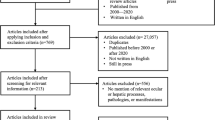Abstract
Oxidative stress appears to be important in the causation and perpetuation of tissue injury and fibrosis in systemic sclerosis or scleroderma (SSc). We conducted a case-control study to assess lipid peroxidation levels as determined by measuring fasting plasma malondialdehyde (MDA) and serum levels of the trace elements selenium, iron, zinc and copper in SSc. Plasma MDA levels were almost tenfold higher in patients than in controls (p=0.00007), and an inverse relationship between MDA levels and disease duration (r=–0.52, p=0.044) was observed. Selenium levels were lower in patients than in controls (p=0.012). Within the patient cohort, copper correlated inversely with the total skin score (r=–0.52, p=0.03). Our findings provide further evidence that lipid peroxidation is increased and antioxidant capacity is reduced in SSc. The gradual decline in MDA levels with time suggests that antioxidant therapy, if to be useful in SSc, is most likely to be effective early in the course of the disease.


Similar content being viewed by others
References
Herrick AL, Rieley F, Schofield D, Hollis S, Braganza JM, Jayson MIV (1994) Micronutrient antioxidant status in patients with primary Raynaud's phenomenon and systemic sclerosis. J Rheumatol 21:1477–1483
Simonini G, Cerinic MM, Generini S, Zoppi M, Anichini M, Cesaretti C et al (1999) Oxidative stress in systemic sclerosis. Mol Cell Biochem 196:85–91
Stein CM, Tanner SB, Awad JA, Roberts LJ 2nd, Morrow JD (1996) Evidence of free radical-mediated injury (isoprostane overproduction) in scleroderma. Arthritis Rheum 39:1146–1150
Belch JJF (1991) Raynaud's phenomenon: its relevance to scleroderma. Ann Rheum Dis 50:839–845
Lau CS, Bridges AB, Muir A, Scott N, Bancroft A, Belch JJF (1992) Further evidence of increased polymorphonuclear activity in patients with Raynaud's phenomenon. Br J Rheumatol 31:375–380
Tew MB, Reveille JD, Arnett FC, Friedman AW, McNearney T, Fischbach M et al (2001) Glutathione S-transferase genotypes in systemic sclerosis and their association with clinical manifestations in early disease. Genes Immun 2:236–238
Palmer CN, Young V, Ho M, Doney A, Belch JJ (2003) Association of common variation in glutathione S-transferase genes with premature development of cardiovascular disease in patients with systemic sclerosis. Arthritis Rheum 48:854–855
Tikly M, Marshall SE, Haldar NA, Gulumian M, Wordsworth P, Welsh KI (2004) Oxygen free radical scavenger enzyme polymorphisms in systemic sclerosis. Free Radic Biol Med 36:1403–1407
Lundberg A-C,Åkesson A, Åkesson B (1992) Dietary intake and nutritional status in patients with systemic sclerosis. Ann Rheum Dis 51:1143–1148
Herrick AL, Worthington H, Rieley F, Clarke D, Schofield D, Braganza JM et al (1996) Dietary intake of micronutrient antioxidants in relation to blood levels in patients with systemic sclerosis. J Rheumatol 23:650–653
Murrell DF (1993) A radical proposal for the pathogenesis of scleroderma. J Am Acad Dermatol 28:78–85
Del Maestro RF, Thaw HH, Bjork J, Planker M, Arfors KE (1980) Free radicals as mediators of tissue injury. Acta Physiol Scand 492:43–57
Solans R, Motta C, Sola R, La Ville AE, Lima J, Simeon P et al (2000) Abnormalities of erythrocyte membrane fluidity, lipid composition, and lipid peroxidation in systemic sclerosis: evidence of free radical-mediated injury. Arthritis Rheum 43:894 900
Halliwell B, Gutteridge JMC (1999) Free radicals in biology and medicine. Oxford University Press, Oxford
Casciola-Rosen L, Wigley F, Rosen A (1997) Scleroderma autoantigens are uniquely fragmented by metal-catalysed oxidation reactions: implications for pathogenesis. J Exp Med 185:71–79
Poli G, Parola M (1997) Oxidative damage and fibrogenesis. Free Radic Biol Med 22:287–305
Subcommittee for Scleroderma Criteria of the American Rheumatism Association Diagnostic and Therapeutic Criteria Committee (1980) Preliminary criteria for the classification of systemic sclerosis (scleroderma). Arthritis Rheum 23:581–590
LeRoy EC, Black C, Fleischmajer R, Jablonska S, Krieg T, Medsger TAJ et al (1988) Scleroderma (systemic sclerosis): classification, subsets, and pathogenesis. J Rheumatol 15:202–205
Tager RE, Tikly M (1999) Clinical and laboratory manifestations of systemic sclerosis (scleroderma) in Black South Africans. Rheumatology 38:397–400
Clements PJ, Lachenbruch PA, Seibold JR, White B, Weiner S, Martin R et al (1995) Inter- and intra-observer variability of total skin thickness score (modified-Rodnan) in systemic sclerosis (SSc). J Rheumatol 22:1281–1285
Fries JF, Spitz P, Kraines RG, Holman HR (1980) Measurement of patient outcome in arthritis. Arthritis Rheum 23:137–145
Wong JW, Ebeler SE, Rivkah-Isseroff R, Shibamoto T (1994) Analysis of malondialdehyde in biological samples by capillary gas chromatography. Anal Biochem 220:73–81
Jiminez SA, Hitraya E, Varga J (1996) Pathogenesis of scleroderma. Rheum Dis Clin North Am 22:647–674
Denton CP, Bunce TD, Dorado MB, Roberts Z, Wilson H, Howell K et al (1999) Probucol improves symptoms and reduces lipoprotein oxidation susceptibility in patients with Raynaud's phenomenon. Rheumatology 38:309–315
Herrick AL, Hollis S, Schofield D, Rieley F, Blann A, Griffin K et al (2000) A double-blind placebo-controlled trial of antioxidant therapy in limited cutaneous systemic sclerosis. Clin Exp Rheumatol 18:349–356
Leonarduzzi G, Scavazza A, Biasa F, Chiarpotto E, Camandola S, Vogl S et al (1997) The lipid peroxidation endproduct 4-hydroxy-2,3-nonenal up-regulates transforming growth factor-b1 expression in the macrophage lineage: a link between oxidative injury and fibrosclerosis. FASEB J 11:851–857
Gries CL, Scott ML (1972) Pathology of selenium deficiency in the chick. J Nutr 102:1287–1296
Author information
Authors and Affiliations
Corresponding author
Rights and permissions
About this article
Cite this article
Tikly, M., Channa, K., Theodorou, P. et al. Lipid peroxidation and trace elements in systemic sclerosis. Clin Rheumatol 25, 320–324 (2006). https://doi.org/10.1007/s10067-005-0013-4
Received:
Accepted:
Published:
Issue Date:
DOI: https://doi.org/10.1007/s10067-005-0013-4




